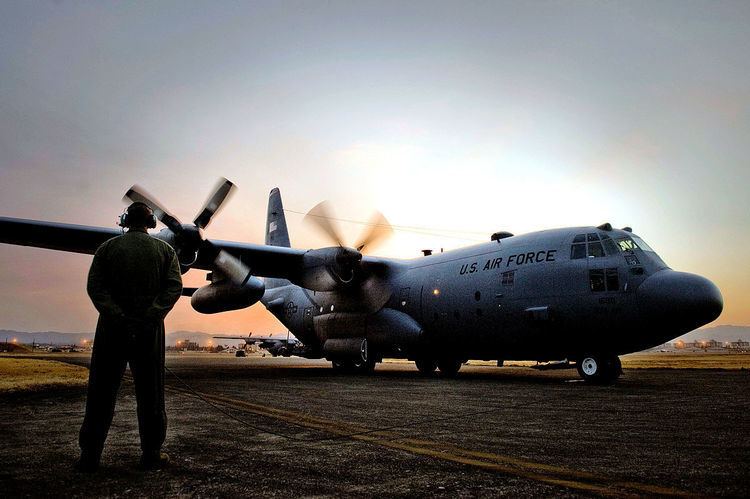Role Airlift | ||
 | ||
Active 1942–1957; 1966-1968; 1968-Present Part of Pacific Air Forces5th Air Force374th Airlift Wing374th Operations Group | ||
The 36th Airlift Squadron (36 AS) is the only forward-based tactical airlift squadron in the Pacific Area of Responsibility. Formerly an Air Mobility Command (AMC) unit, and a Military Airlift Command (MAC) and a Tactical Air Command (TAC) unit before that, the squadron is now part of Pacific Air Forces (PACAF). It maintains a forward presence and supports combat operations by providing responsive movement of personnel and equipment through aerial delivery and assault airland operations. It maintains C-130H Hercules mission-ready aircrews to conduct theater airlift, special operations, aeromedical evacuation, search and rescue, repatriation and humanitarian relief missions.
Contents
Mission
Provide services and support, which promote quality of life and project global power through combat-proven airlift and airdrop.
History
Activated in February 1942 at Patterson Field, Ohio as the 36th Transport Squadron. Trained at various stations in the southeast and Texas with C-47 Skytrain transports. Deployed to Egypt in November 1942 as part of President Roosevelt's decision to aid the Royal Air Force Western Desert Air Force, assigned to the newly established Ninth Air Force, headquartered in Cairo.
Transported supplies and evacuated casualties in support of the British Eighth Army, operating from desert airfields in Egypt and Libya. Reassigned in May 1943 to Twelfth Air Force in Algeria, supporting Fifth Army forces in the Tunisian Campaign. Began training for the invasion of Sicily; dropped paratroops over the assault area on the night of 9 July. Carried reinforcements to Sicily on 11 July and received a Distinguished Unit Citation for carrying out that mission although severely attacked by ground and naval forces; dropped paratroops over the beachhead south of the Sele River on the night of 14 September 1943. Remained in the Mediterranean Theater of Operations until February 1944 until being reassigned back to IX Troop Carrier Command to participate in the buildup of forces prior to the Allied landings in France during D-Day in June 1944.
Engaged in combat operations by dropping paratroops into Normandy near Ste-Mere-Eglise on D-Day (6 June 1944) and releasing gliders with reinforcements on the following day. The unit received a third Distinguished Unit Citation and a French citation for these missions.
After the Normandy invasion the squadron ferried supplies in the United Kingdom. The squadron also hauled food, clothing, medicine, gasoline, ordnance equipment, and other supplies to the front lines and evacuated patients to rear zone hospitals. It dropped paratroops near Nijmegen and towed gliders carrying reinforcements during the airborne attack on the Netherlands. In December, it participated in the Battle of the Bulge by releasing gliders with supplies for the 101st Airborne Division near Bastogne.
Returned to the United States in May 1945, becoming a domestic troop carrier squadron for Continental Air Forces. In the Korean War the squadron flew airborne assaults at Sukchon and Munsan-ni and aerial transportation between Japan and Korea. Returned to the United States in 1952, however re-deployed back to Japan in 1954 and performed theater airlift missions. Inactivated in 1957 as part of the draw down of occupation forces in Japan.
Reactivated in 1966 at Langley AFB, Virginia as the 36th Troop Carrier Squadron (36 TCS), a Tactical Air Command troop carrier squadron under the 316th Troop Carrier Wing 9316 TCS) with C-130E Hercules aircraft. Redesignated as the 36th Tactical Airlift Squadron (36 TAS) in 1967 concurrent with parent wing's redesignation as the 316th Tactical Airlift Wing (316 TAW). Deployed frequently to NATO and U.S. Air Forces in Europe (USAFE), sending aircraft to both England and West Germany.
In early 1975, operational claimancy of the unit shifted from Tactical Air Command (TAC) to Military Airlift Command (MAC). When Langley AFB became the first operational F-15 base in the Air Force for the 1st Fighter Wing in 1975, the 316th Tactical Airlift Wing and two of its three airlift squadrons were inactivated. As the sole surviving airlift squadron, the 36 TAS moved to McChord AFB, Washington where it operated C-130s under Military Airlift Command's 62nd Military Airlift Wing (62 MAW), both within the United States and during rotational deployment of aircraft and crews to Howard AFB, Panama in support Operation CORONET OAK, providing airlift support for United States Southern Command throughout Central and South America. It also participated and supported the ground troops during Operation Urgent Fury in Grenada from October to November 1983, and Operation Just Cause in Panama from December 1989 to January 1990.
In 1989, the squadron transitioned from the C-130E to the C-141B Starlifter, flying that aircraft until 1993. In 1993, the squadron transitioned back to the C-130, this time the C-130H, and was reassigned from McChord AFB back to Japan, this time to Yokota AB, where it performs its current theater airlift mission.
The squadron took part in Operation Tomodachi, the response by the USAF to the 2011 Tōhoku earthquake and tsunami, flying relief supplies to Sendai Airport, and in 2013 deployed aircraft to the Philippines for relief missions following Typhoon Haiyan. It is due to begin re-equipping with the Lockheed Martin C-130J Super Hercules late in 2016. It will receive 14 C-130Js in all.
